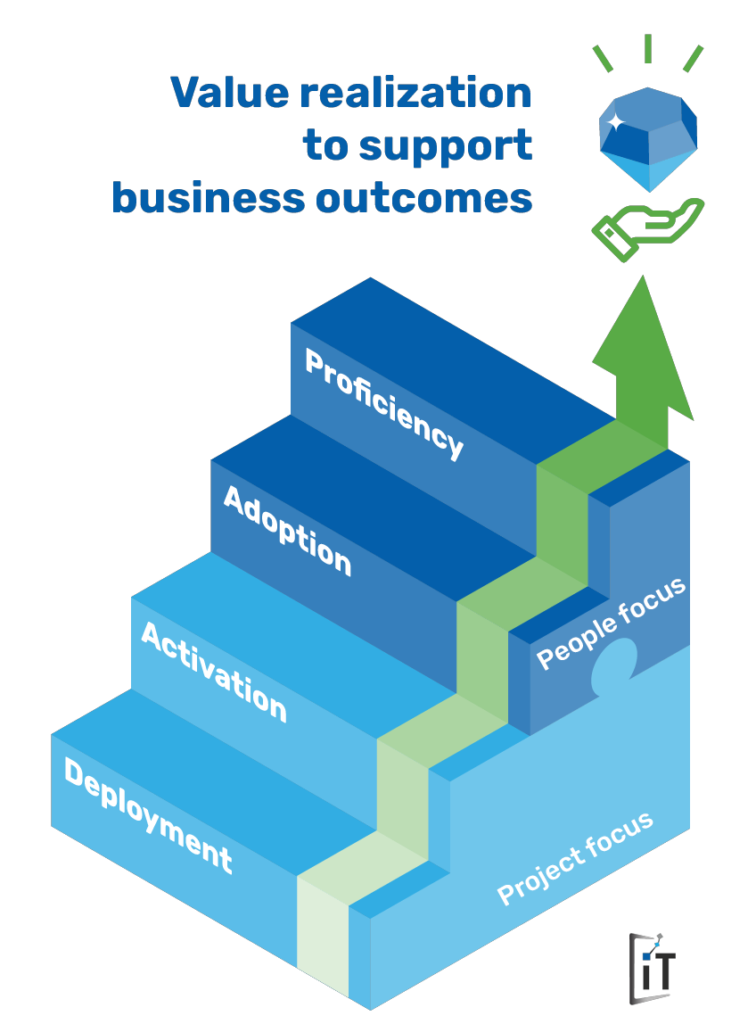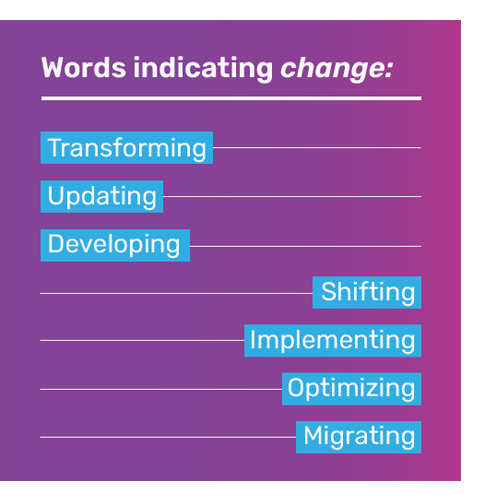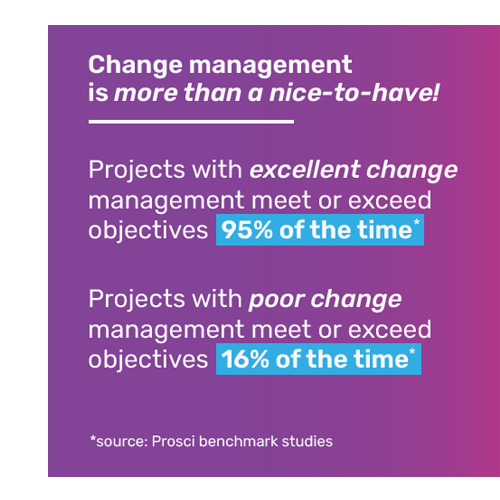Why and how to add change management to your project management approach

As a project manager, you have probably seen first-hand the challenges in getting people in your organization to adopt new systems, processes, thinking, or behaviors. As an employee, you’ve almost certainly been on the receiving end of change and been frustrated at some aspect of it!
But what can you do about it? As it happens, you’re in an ideal position to make a difference because many of the skills that make you a good project manager are the same skills you need to be a good change manager.
Change management is what facilitates the adoption of the projects you’re working on. So, arming yourself with a basic understanding of change management will enable you to better ensure the adoption and success of the projects you are implementing.
What you need to know about change management
There are a few things we know for sure about change…
- People don’t automatically change. Resistance is a normal, human behavior that takes time to overcome.
- Solutions are more than an implementation. The idea that if you build something, people will come, doesn’t necessarily work. People become attached to the things they’re familiar with and the way they’re used to doing things. That’s why habits are so hard to break!
- Addressing communications and training during the last mile of a project isn’t enough. Driving adoption requires planning and engagement from the beginning. These things take time to develop, and they often bump into attention and availability constraints when it comes time to deploy.
- People and change are not a one-size-fits-all proposition. Change is personal, and it requires understanding the change up front to tailor the right enablement to drive adoption.
So, yes, change can be hard. Nothing new about that! The question is, what can you do about it?
This is where change management comes in. There are a lot of definitions out there, but they all boil down to a set of structured processes, tools, and activities that prepare people to do things differently. Done well, it ensures the right people are ready at the right time to achieve the desired outcomes. It’s all about people – not just capabilities – and how they change their behavior.
When to apply change management
 Both project management (PM) and change management (CM) approaches are important and needed for successful project outcomes. PM is all about deployment & activation of the project.
Both project management (PM) and change management (CM) approaches are important and needed for successful project outcomes. PM is all about deployment & activation of the project.
As a project manager, you are often required to parachute in to do a project with minimal context.
PM and even scrum training tends to emphasize “build the system,” glossing over the people dynamics and the process of helping them develop new ways of working to make it successful.
CM goes beyond processes and gets to peoples’ motivation and ability to do what it takes to make a change stick.
PM and CM should work hand in hand at the project level. Effective integration of PM and CM activities throughout a project’s lifecycle is the key to success.
The good news is, there are some easy steps you can take to incorporate more CM into the projects you’re working on!
STEP ONE: IDENTIFY THE NEED
So, how do you identify the need for change management at the project level?
As a project manager, you’re in an ideal position to do this because you’re on the front line of project planning and deployment.
Just watch and listen for words and phrases that indicate that something is changing!
 You can also observe what’s going on around you for signs that change management is needed. Just ask yourself:
You can also observe what’s going on around you for signs that change management is needed. Just ask yourself:
- How much time are people spending pulling together and manipulating data to talk about the impacts and plans?
- Is anyone reaching across workstreams to look at the overall stakeholder impacts and engaging stakeholders to verify the impact and degree of impact?
- Do the leaders who need to support the project really get it?
- Who else needs to be involved to motivate or enable people to adjust to the changes?
- Do the people driving communications and training struggle to get the information they need to develop content or schedule activities?
STEP TWO: MEASURE THE NEED
As a next step, consider conducting a Change Magnitude Assessment (CMA) by gathering information from a few informed project and business leaders. The CMA allows you to scope the size and complexity of change – the level of need – at a high level before a project gets fully underway.
Most CMA templates measure things like:
- the number of people affected
- impacts across areas
- changes that will be needed for jobs, processes, and behaviors
- dependencies
- policies
- systems
- the timeframe
- ROI
- risks
iTalent Digital uses the CMA as a cornerstone of our Change Management Practice, so ask us about it if you’re trying to measure your project’s need for change management!
If the change has high complexity and highly impacted stakeholders, it may warrant dedicated CM support.
STEP THREE: BUILD CHANGE MANAGEMENT CAPABILITIES
Now you can use the data you’ve gathered about the need for change management to make the case to people in your organization who can influence or dedicate resources to address that need.
dedicate resources to address that need.
Here are a few “if… then…” scenarios to determine your next steps:
- If you are a business or PMO leader, then consider strengthening change management in your organizational or project structure.
- If you are part of a project/program management office (PMO) or are a program manager and change management is not yet part of your structure, then set up a change management office (CMO) or engage change management services (internal or external).
- If the PMO is managing change services or you are a project manager with responsibility for change management, then partner with existing change managers or incorporate change management methods and tools into your approach.
- If you see a need for CM support, whether or not there are CM services already assigned to the project, then find a CM expert to help you make the case. It’s always best to first connect with other people in your organization who already champion CM and then partner with them on your approach.
- If you are the person responsible for CM, focus on building your CM skills to make a bigger impact on project outcomes. One of the best places to start your CM skills journey is through the Association of Change Management Professionals (ACMP).
iTalent can help you with all of these things, and more! Contact us at change@italentdigital.com.
Elevate change management to the enterprise level
If your organization is already adept at change management within projects, but projects are often butting up against each other and competing for resources, it may be time to consider an enterprise change management (ECM) approach.
ECM streamlines and aligns the approach to change across initiatives and stakeholders, using proactive planning and data to inform decisions. It creates visibility, consistency, and accountability in projects across the enterprise.
Contact us at change@italentdigital.com and ask us for more information on how you can seed an enterprise-wide ability to flex with change to deliver critical gains across your organization.
You may also like:
The Federated Model of strategic change management
3 things successful change leaders do



